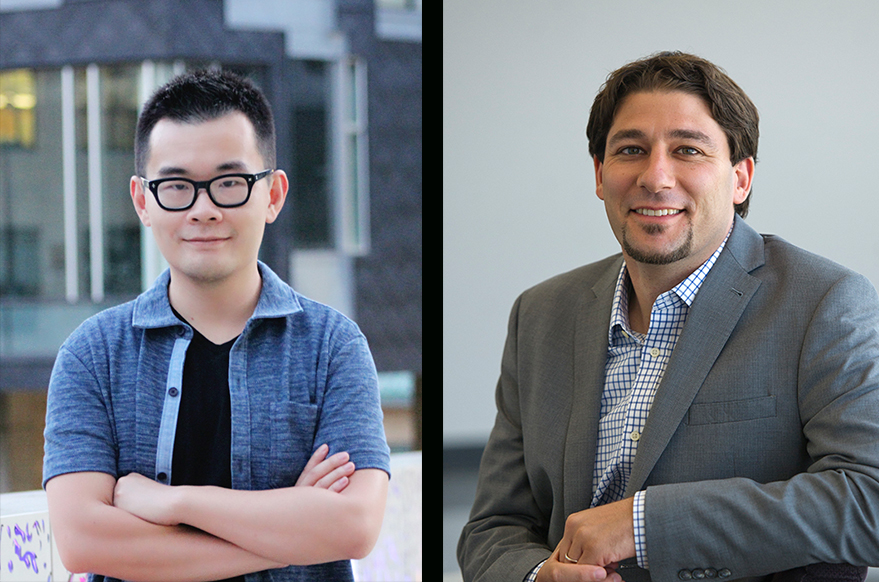
Rising Research Stars
(Santa Barbara, Calif.) — Two of UC Santa Barbara’s junior engineering faculty members have received the prestigious Young Faculty Award from the U.S. Defense Advanced Research Projects Agency (DARPA). William Wang, in the College of Engineering’s Department of Computer Science, and Jonathan Klamkin, in the Department of Electrical and Computer Engineering, join 34 other up-and-coming researchers for 2018.
“We’re extremely proud of William Wang and Jonathan Klamkin for receiving their DARPA Young Faculty Awards, and we offer them enthusiastic congratulations on this recognition of their outstanding achievements,” said Rod Alferness, dean of the UCSB College of Engineering. “They continue a strong tradition of junior faculty being recognized for outstanding work, and in doing so, ensure that UCSB engineering is in good hands for the future.”
Modeling Misinformation
How does misinformation go viral? How does false information bypass our usual filters and spread like wildfire? This is the mystery that Wang seeks to unravel with his project, “Dynamo: Dynamic Multichannel Modeling of Misinformation.”
“The goal of this research is to automatically learn explainable patterns of misinformation spread from information networks and text data,” said Wang, an assistant professor whose specialty lies in the relatively new and very hot field of Natural Language Processing (NLP) — a branch of artificial intelligence that is concerned with how humans and computers communicate (think Siri and Alexa, speech recognition and machine translation). “We aim at connecting the dots and creating abstractions of common misinformation dissemination patterns.”
Integrating multiple channels of information, including text, structure, image, audio and video, the Wang research group’s multimodal modeling framework will trace the paths of misinformation spread. Through deep reinforcement learning — whereby the machine essentially teaches itself to learn through incremental decisions to maximize an ideal result — the path-finding approach becomes a dynamic solution modeling spatial-temporal variations in misinformation propagation schemes. Additional components of the project will focus on the nuances of misinformation, such as subtle wording, as well as the development of an active verification system based on multi-document reading comprehension.
“I’m very honored to receive this young investigator award,” Wang said. “This is the second time in the history of the program that the DARPA Young Faculty Award has been awarded to a Natural Language Processing researcher.”
In his two years at UCSB, Wang has grown the campus’s NLP research into one of the world’s most prolific natural language processing labs. His work has also contributed toward UCSB’s top three ranking for NLP in 2018 by CSRankings.org — ahead of Stanford, Berkeley and MIT. Wang also has been the recipient of several best paper awards, as well as research awards from Facebook, Adobe and IBM.
Smarter, Faster, More Efficient
Modern life changed in the mid-20th century when the electronic integrated circuit took the world by storm, bringing advances in computing and the many devices made possible by that feat of engineering. Today we stand at the cusp of a similar revolution, this time with photonic integrated circuits, which transfer information with light instead of electricity. Not only can light carry more information, but it can sense and process information in innovative ways.
Klamkin, an associate professor of electrical and computer engineering, is among those working to bring about the photonics revolution. With his DARPA project "ASPIC (Attojoule Sources for Photonic Integrated Circuits)," he aims to address the energy consumption issues associated with lasers, the sources of light in photonic integrated circuits. Confronting that challenge is a must if photonic integrated circuits are to be reliable and to reach their potential for the large-scale integration associated with electronic integrated circuits.
“We aim to drastically reduce the power consumption of laser diodes that provide the optical sources for photonic integrated circuits,” said Klamkin, who leads the Integrated Photonics Laboratory at UCSB. "Such a luxury would make photonic circuits ubiquitous in the same way that electronic circuits have become a mainstay in computers, smartphones, medical instruments, sensors and automobiles."
“It is an honor to receive this award,” Klamkin said. “DARPA is highly recognized for its commitment to cutting-edge research. I’ve had the privilege to work with DARPA for more than 15 years on various programs and this award represents a unique opportunity for students and me to investigate truly foundational technology. I’m also excited for the interactions we will have with our terrific program manager and for the interesting events and site visits organized for the young investigators under this program.”
Klamkin, who joined the UCSB faculty in 2015, is also the recipient of a NASA Early Career Faculty award. He and his group have been recognized with several best paper awards. Klamkin has authored or coauthored more than 180 papers, holds several patents and has delivered more than 60 invited talks and tutorials.
About the DARPA Young Faculty Award
The objective of the DARPA Young Faculty Award (YFA) program is to identify and engage rising research stars in junior faculty positions at U.S. academic institutions and introduce them to Department of Defense needs as well as DARPA’s program development process.



